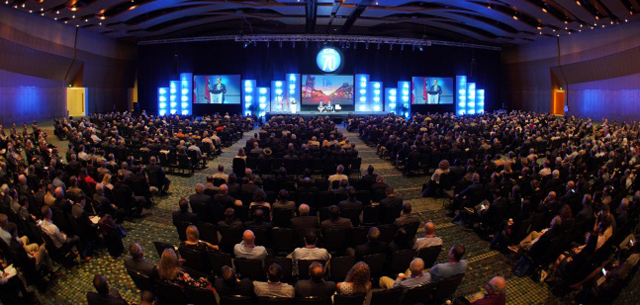

Thank You for Attending the 2018 ACI-NA Annual Conference and Exhibition!
Following several days of jam-packed thought leadership, educational sessions, and enhanced networking, the 2018 ACI-NA Annual Conference and Exhibition came to an end on October 2 with a celebratory closing night event at The Country Music Hall of Fame. This year’s conference was a celebration to remember with over 2,300 registered attendees and 310 exhibit booths!
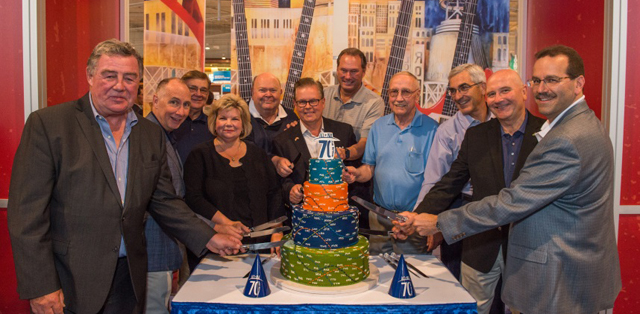
Did you enjoy Music City? We think it brought out the best in everyone!
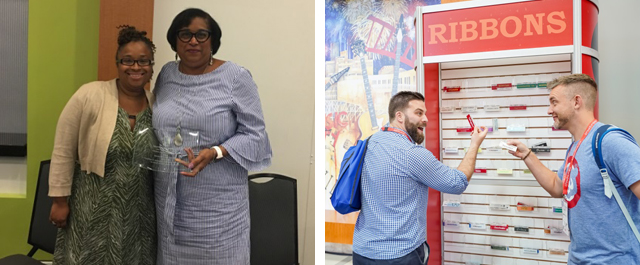
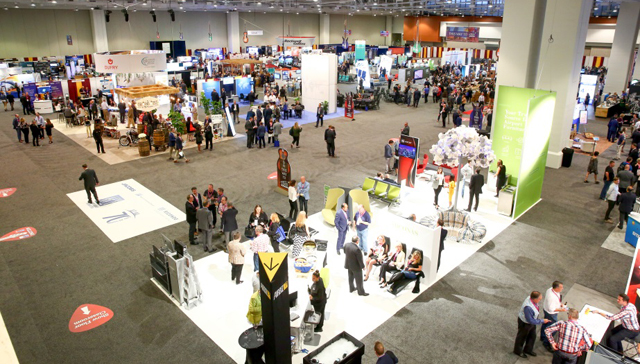
|
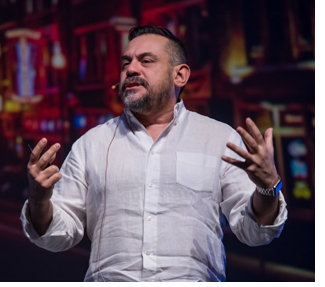 600,000 miles a year in the air. And if that nugget of information didn’t get your attention, then there were probably quite a few other statements made by Keynote Leonard Brody during General Session I that would have given you reason to listen closely to what he had to say. 600,000 miles a year in the air. And if that nugget of information didn’t get your attention, then there were probably quite a few other statements made by Keynote Leonard Brody during General Session I that would have given you reason to listen closely to what he had to say.
Not only did Brody share “a decade’s worth of research in 50 minutes,” he let everyone see a bit of what makes him tick, what inspires him and what changes he thinks the airport industry should be making – though there were a few that differed on those comments.
One of Brody’s recurring points was the value of “human currency” and the changes there. “The big story is the changes in human beings,” he said. Businesses will fail if they don’t pay attention to change. Technology has “enslaved” us, to a degree, and there is a disconnect going on. “The houses we built don’t fit the people who live here anymore.” The disconnect is between “the people we have become, the tech tools available to us and the failure of our institutions to keep pace,” he said.
Behaviors of people have changed too. Our virtual selves are dominant, as two-thirds of our day is spent in a virtual world and only a third in the physical one. And people behave differently as a virtual self than in a physical one, he said. Interestingly, he said people are four times more trusting of virtual form than physical. Also, these virtual worlds, such as virtual performances, are already infiltrating the music scene and “the people walking through your airport doors are part virtual and part physical.”
As a person who travels extensively by plane, he has deduced that there are two demographics in airports: people who travel a lot and people who don’t. It is a comparison of “the value of time versus the necessity of the passing of time” when looking at the two. The goal is to create experiences for both.
And just as innovation never ceases, neither do experiences. "Life continually evolves. We don’t control that….Things evolve and we have to look at the path of that evolution.”
|
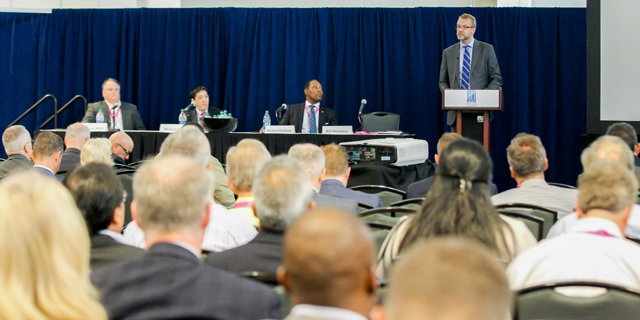
If you knew your loved ones or friends would be impacted by a serious illness and you had the ability to prevent it, would you? This question posed by Michael Stephens, General Counsel, EVP Information Technology, Tampa International Airport, was just hypothetical, but it raised a very valid point about cyberattacks. Probably everyone in the room was thinking, “Of course!” But, this is the case with cyberattacks, as well, and everyone is NOT doing something to prevent it. “There are vulnerabilities out there for all of us. It is spooky, spooky out there… and people don’t want to hear it,” said Stephens. “We can help prevent what is inevitably going to happen.”
Moderator RJ Steenstra, President and CEO, Fort McMurray Airport Authority, has first-hand experience with “the inevitable.” In 2016, ransomware called Dharma shut down the administration servers for nine full days, he said. Complete reprogramming was required, which took 6-8 weeks. “We were lucky, though,” he said. “It didn’t compromise data.”
And, and in this day and age, “Data has become the new gold bullion,” said Stephens. And the enemy that is trying to cripple the industry uses computers, keyboards and kiosks for tools. However, and as Michael Yip, VP, Risk Management Dallas Fort-Worth International Airport, pointed out, “It is one thing to understand there is a problem, another to address it.” At DFW, they take a holistic view of cybersecurity as “you have to understand the interconnectivity of it all.” Their organizational resiliency framework consists of Recognize, React, Respond and Recover.
For Terrance Kirk, Vice President, Aviation Information Sharing and Analysis Center (A-ISAC), the best way to combat cyberattacks is to “provide situational awareness, where companies can share cyberthreat security indicators in a non-competitive way,” which is where A-ISAC comes in. A-ISAC has the goal of “building a more cyber-resilient industry” and is actively engaging in partnerships worldwide in order to establish that framework.
The key is to understand that it is a real problem. “We are dealing with a very evolving and persistent threat,” said Stephens. “They are like ticking time bombs.” Airports may see millions of attacks each year. There is a probability some are going to get through. “We need to start adopting a standard at our airports. Otherwise, they will set it for us,” he explained. This would allow us to assess the risks, costs and benefits. “If I can leave you with one thing: Make sure you are having a dialogue about a standard to adopt.”
|
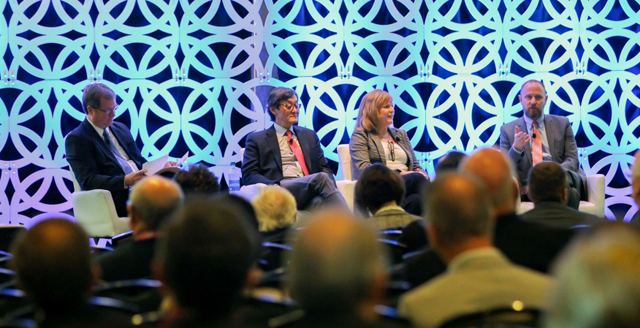
Airports all over are struggling to address ground transportation difficulties. In the session “The Long and Winding Last Mile: Improving Airport Ground Access,” Mark Duebner, Director of Aviation, City of Dallas Department of Aviation, Margaret McKeough, EVP & COO, Metropolitan Washington Airports Authority and Howard Eng, President & CEO of the Greater Toronto Airports Authority discussed the different approaches their airports are using to tackle the influx of ground transportation obstacles.
Dallas Love Field began planning parking renovations back in 2009 before TNCs existed and before the impact of these services was known. As services like Uber and Lyft gained popularity and strained ground access, the team made changes to the planned layouts, Duebner said, to accommodate TNC pick-ups and drop-offs, including moving taxi cabs and doubling the amount of land space for TNCs. Ensuring smooth operations for all vehicles accessing the airport is an ever-evolving process and Dallas Love Field is still considering other options to keep vehicles flowing through the airport, including providing a second option for airport access from arterial roadways serving northern neighborhoods and linking to regional transportation corridors.
McKeough said that Dulles International Airport began addressing the issue of ground access to the airport years ago when airport operators had the foresight to reserve land to bring the metro system out to the airport to connect it to Washington D.C. in advance of needing it. McKeough explained that the issue Dulles faces is that infrastructure in Northern Virginia hasn’t kept up with the airport’s needs and the airport’s 12,000 acres straddle two counties and depends on government and state services to operate. To help ease this strain, MWAA offered to and currently manages both the Dulles Toll Road and construction of the metro expansion.
Toronto Pearson International Airport faces similar issues in being a multi-jurisdictional airport, said Eng. Roadway access and transportation is difficult in the area surrounding the airport. As the regional need for roadway access and transportation has grown, the airport has looked to public transportation to ease the strain and provide access to other points of interest throughout the region.
“An airport is never the final destination,” Eng said.
|
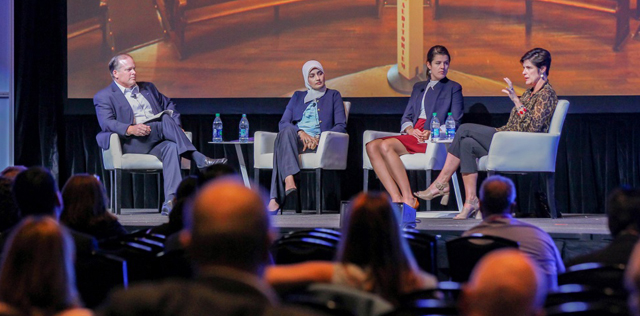
The session “Incorporating a Culture of Innovation” brought together executives to discuss how airports, airlines and concessionaires are incorporating innovation to effectively respond to trends affecting the ever-changing airport environment. Christina Cassotis, CEO of Allegheny County Airport Authority, Christina Heggie, Investment Principal, JetBlue Technology Venture, and Sarah Naqvi, EVP and CIO, HMS Host Corporation explained how they approach innovation in their businesses.
When Cassotis started at the Allegheny County Airport Authority, change was needed but it wasn’t happening. She was hired to disrupt a culture that wasn’t moving forward and addressing airport operations in an innovative way. She said that the issue many organizations run into is that they try to “innovate in a black box” before taking it to the rest of the organization and saying “implement this.” Cassotis explained that this method doesn’t work because it doesn’t get anyone talking about how to actually solve problems and lacks buy-in from the whole organization.
Heggie explained that JetBlue Technology Venture wants to make the airport the destination, a place where people want to go. Knowing what the passenger needs are and addressing them is the first step in that process. JetBlue Technology Venture works to find companies and technology that are encouraging change. They look for those not just making change in the immediate future, but further along, to stay relevant and continue to be relevant for years. Heggie also said that looking 30 years out, she thinks that going through the whole airport experience could be optional for travelers, making knowing and addressing those passenger needs all the more important.
From a concessionaire’s point of view, Naqvi sees the complexity and variety of brands within airports as the biggest challenge. The siloed approach that’s long been used makes it difficult to synchronize the experience across airports, brands and locations. By making customers, not the brands, the focus, concessionaires can create a common platform for their products wherever they are and ease customer fatigue, while creating that synchronized experience they’ve been looking for.
|
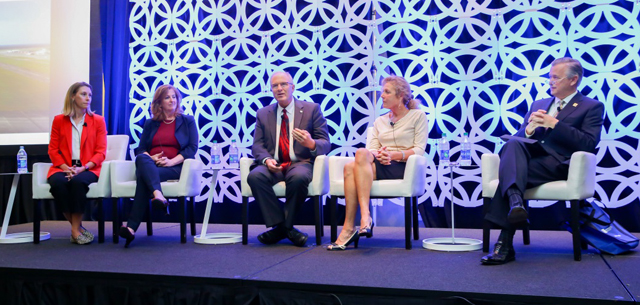
In 1909, 109 years ago, the first commercial airport opened in Maryland. Today, there are 5,116 public airports and 14,485 private airports. Now, think of that in a commercial space context with “now” being the beginning of what may be exponential growth in that arena. “We are exactly in the same position with commercial space,” said Steve Grossman, CEO, Jacksonville Aviation Authority, “specifically horizontal launch,” at least at Jacksonville’s Cecil Spaceport, the site of the first (and only) horizontal launch spaceport license. Not only that, but the spaceport is already complete and “sometime in 2019, we expect the first commercial launch” via Generation Orbit, which has a contract with the U.S. Air Force.
There are 11 licensed launch and reentry sites in the U.S., with the most recent, Colorado, being licensed a couple of months ago, said Dorothy “Di” Reimold, Acting Deputy Associate Administrator for Commercial Space for the U.S. Federal Aviation Administration’s Office for Commercial Space Transportation (FAA AST). On FAA’s side, it is a testing ground too. While Aviation is regulated under FAA’s Title 49 United States Code, Commercial Space Transportation is under Title 51. “We have three active Aviation Rulemaking Committees (ARCs) related to commercial space transportation,” said Reimold. Plus, they are trying to come into a mode of operation that “is more akin to how the FAA manages aviation.” A program was launched called the Space Data Integrator “to more fully automate the space data directly so it can be calculated much more quickly,” she explained.
Sharon Pinkerton, Senior Vice President, Legislation and Regulatory Policy, Airlines for America, shared a different perspective: the challenges that space flight creates for airline flights. For example, “whole swaths of airspace have to be shut down” when a space flight is planned, which will have an impact on commercial aviation flow. And, “operational and safety impacts need to be addressed,” she emphasized.
Safety is of primary importance for all involved in commercial space, but especially so for SpaceX, a private entity that has 15 launches already under its belt for 2018. Caryn Schenewerk, Senior Counsel and Senior Director, Space Flight Policy, SpaceX, said, “Soon we’ll be carrying astronauts to the space station.” Their vehicles include: Dragon, Falcon 9, Falcon Heavy and BFR (Big Falcon Rocket). “We signed a customer to fly around the moon on BFR,” said Schenewerk, mentioning that SpaceX is the first private entity to launch, dock and bring a rocket back. “We can reuse our boosters up to 10 times without major work.”
For everyone involved, the challenge is going to be in the unknown. There is no route to follow, so trailblazing is the only way to go. “This is all very new for everyone,” said Grossman. “We are really looking forward to the future of all of this.”
|
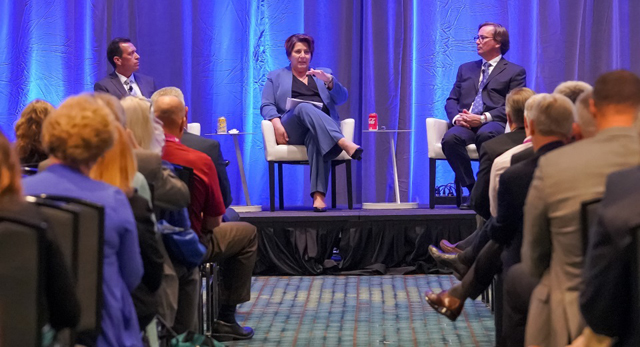
As professionals in the industry know, airports are highly regulated entities. During the session, "Airport Regulatory Forum," airport operators got to hear from the Federal Aviation Administration’s Acting Associate Administrator Winsome Lenfert and Transport Canada's Chief, Flight Standards-Standards Branch, Pierre Ruel, as they discussed ongoing regulatory reform efforts from both agencies.
Lenfert mentioned that the top issue at the moment for the FAA is addressing the increasing number of wrong surface landings at airports. The FAA is working to assemble a team to mitigate these risks associated with taking off and landing at airports. In Canada, Ruel noted that Transport Canada is working to engage stakeholders on their regulatory efforts as well as consider the social economic factors in regulating smaller airports.
"Do we regulate the small airports?" Ruel rhetorically asked. "Or, keep regulations to the large airports? Where do we draw the line?"
From environmental and policy initiatives to airport funding, airports also had the opportunity to weigh in with these regulators on the challenges facing their airport operations.
Noise was an issue brought up from airports in both the United States and Canada. Lenfert admitted FAA could have done a better job educating local communities on noise and the roll out of NextGen. Learning from the past, they are now doing more outreach with communities and working with the airport industry on how to best communicate noise with the public and local communities.
"As long as you have airports, you are going to have noise," said Lenfert. "But, we need to make sure we are having those conversations on noise."
Similarly, Ruel stated that NAV Canada is doing everything they can to undertake how to best mitigate the noise problem surrounding airports.
The engaging and informative session highlighted the number of regulations facing North American airports and both agencies stressed the need for collaboration with their airport partners to address these challenges in the near future.
"When we are working together I think it makes it a lot stronger for communication on safety issues," said Lenfert.
|
|
| |
|

